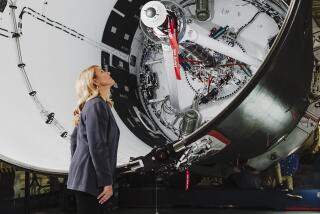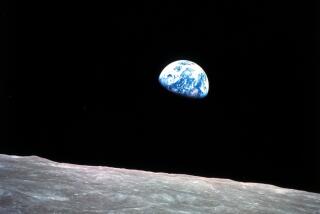After Fighting Fame, Buzz Aldrin Finally Finds Peace on Earth
- Share via
Buzz Aldrin’s training as an astronaut, scientist and pilot prepared him for for his walk on the moon but not his return to Earth.
On July 24, 1969, Edwin E. “Buzz” Aldrin Jr. splashed down an international hero--obligated to abandon his career goals and family life for a strange tour of duty: ceremonies, parades, banquets, speeches, overseas goodwill tours and news conferences.
The identity change--from MIT doctor of astronautics, fighter pilot and astronaut to space pitchman--proved brutal. While publicly serving as an American icon, Aldrin battled depression, alcoholism and the unraveling of his 17-year marriage.
Heroes, though, dig deep for inner strength. They strive to save lives. And Aldrin saved his own. Summoning extraordinary courage, maybe more than what he needed to shoot down Soviet MIGs over Korea and ride a rocket to the moon, he broke from a suffocating tether. Through the following decades, he hewed a stronger, truer identity.
Aldrin, now 71, learned what few men do: the pilgrimage within, where self-knowledge and true success lie, is more difficult than the 240,000-mile journey to the moon.
“You make changes, you learn to accept things,” Aldrin said. “You become satisfied with slow progress. Now I’m comfortable and at peace most of the time.”
Aldrin learned the importance of goal-setting from his aviator father, Edwin Sr., whose friends included Orville Wright, Charles Lindbergh and Robert Goddard. Young Aldrin turned personal challenges--his father’s dares, grade school, camp and West Point (where he graduated third in his class)--into stepping stones for a sky-borne career.
“Maybe it was the challenge of flight, the opportunity to fly, the competition of summer camp and the inspiration and discipline of West Point,” Aldrin said. “I think all of those things helped me to develop a dedication and inspired me to get ahead.”
He flew 66 combat missions as a Korean War fighter pilot, earning the Air Force’s Distinguished Flying Cross. He funneled his space fascination into an academic pursuit, earning an MIT doctorate in astronautics after completing a dissertation on spacecraft rendezvous and docking.
A math whiz who was considered one of the brightest astronauts, Aldrin used his analytical talents, experience in guidance and navigation and faith in human ingenuity to devise innovative solutions to NASA’s rendezvous and docking problems.
At the time he was struggling to complete his dissertation, these procedures were handled via computer and radar. Aldrin was convinced that human involvement could make them go more smoothly. He dedicated his complex thesis to NASA’s first astronauts: “Oh, that I were one of them,” he wrote.
Three years later, during a Gemini 12 mission, pilot Aldrin got to test his theories when a broken radar connection threatened Gemini’s docking maneuvers with Agena, a vehicle it had met in orbit. Using the strategies he’d outlined at MIT, Aldrin programmed the computer to complete the docking.
In the early 1960s, the elite few chosen for the space program were Navy test pilots. Aldrin knew this, but gambled on a different career path. He believed NASA brass would appreciate his astronautics knowledge.
In October 1963, he discovered he was right. He became the first astronaut to hold a doctoral degree.
“I think they realized I had credibility [and could] envision new and different ways of rendezvous in orbit,” Aldrin said. “It went a long way to get me into the astronaut program at NASA.”
But though his knowledge would prove important to NASA’s space program, Aldrin experienced enmity from a few colleagues.
“If you were not a ‘right stuff’ test pilot, there was a tendency for them to look down on you,” he said. “There was a degree of competitiveness between Air Force people and the Navy people, and I think, in some ways, it was not constructive and was a little bit damaging.”
Aldrin focused on his professional obligations. During his historic Gemini 12 mission, he set another precedent by utilizing skills he’d picked up as a diver.
During previous missions, astronauts suffered exhaustion during spacewalks and were forced to cut them short. Aldrin realized that slow, methodical underwater movements were somewhat similar to the actions one took in space.
Using this knowledge and his diving experiences, Aldrin moved slowly and gracefully during his spacewalk, rather than struggling against the inertia. The result was a record-setting spacewalk of 5 1/2 hours.
Then, in 1969, came the great watershed event in Aldrin’s life and world history: the Apollo 11 mission. By now a scrupulously trained astronaut, Aldrin looked forward to the journey into space with colleagues Neil Armstrong and Michael Collins. Any fears he had were allayed by his expectations that his skills, positive attitude and problem-solving abilities would aid him on the mission.
“We always worry,” he said. “We’re concerned about what can go wrong and we rely on our ability to prevent those things from happening through knowledge, awareness and training. . . . Maybe you just breathe deeply, look for ways to be prepared, be as alert as possible, and take on a confident air. And expect the best.”
On July 20, 1969, Apollo 11 lunar module pilot Aldrin became the second man to step on the moon. He described its haunting landscape--craters, rocks, grayish dust and pebbles--as “magnificent desolation.” Aldrin helped Armstrong uncover the commemorative plaque: “Here men from the planet Earth first set foot on the Moon. We came in peace for all mankind.”
With Armstrong, Aldrin spent two hours carrying out NASA’s tasks: taking core samples, setting up scientific instruments, collecting rock and soil samples and planting the American flag.
Back on Earth, unprecedented celebrations were taking place. And then, it was time for Aldrin to come home.
“I hadn’t thought that much of what would come afterward,” he said. “After we got back, I was not that prepared or comfortable to be thrust in the public eye that much. It was very intense: traveling around the world, speaking to lots of people.”
The months after his return became a blur of handshaking, speechmaking, autograph signing and hobnobbing. NASA’s itinerary and demands for Aldrin, Armstrong and Collins were almost as grueling as their space training: in one instance, they visited 23 countries in 45 days.
The only flights Aldrin took were those aboard Air Force Two, NASA’s Gulfstream and countless commercial planes and helicopters.
He dutifully attended the banquets, parades, public ceremonies, political engagements and meetings with international heads of state. When he would return exhausted to his office, he’d find it piled high with mailbags.
At first, Aldrin harbored hopes of returning to space, this time as a commander.
But eventually, he abandoned that wish and left NASA in 1971 to return to active Air Force duty as commander of Edwards Air Force Base’s Aerospace Research Pilot School.
“I’m not sure the Air Force knew what to do with someone who went to the moon and came back into service after 11 years,” he said.
Aldrin was beginning to sense that something was very wrong. He tossed and turned at night, experienced mood swings, depression and insecurity. On some days, he couldn’t get out of bed.
His marriage to Joan Aldrin was faltering. In a telling moment, his wife wished aloud that their lives could return to the way they were before Apollo 11. On their 17th anniversary, they decided to divorce.
Aldrin forced himself to make a critical decision. For months, he had hidden from Air Force personnel his emotional difficulties; revealing them would probably curtail his career. But to get well, he needed professional help.
“It eventually became too much,” he said.
Confessing his troubles, he put his career on hold and checked into a hospital for treatment. There, Aldrin, the perennial goal-setter, embarked on his most personal goal: reclaiming his life. He was 41 years old.
He worked hard in therapy to understand his problems. Eventually, he concluded he was experiencing a “melancholy of things done”: He had returned from the moon with no future plans. Engulfed by the public’s furor over his achievements, he had let himself become “an inert Ping-Pong ball being batted about by the whims and motivations of others.”
He vowed to get back on track. “I had to stop and, for the first time, examine my life,” he said.
“I resolved, ‘You’ve been to the moon. You did it. First. It cannot be done again, not by you, not by anyone else. Now get the hell out of here and live the kind of life you want,’ ” he wrote in his autobiography, “Return to Earth,” (Random House, 1973).
Aldrin also had to battle alcoholism before he could start that new life.
Today, after being sober for 22 years, he assists others struggling with the addiction. According to Richie Annenberg, a Los Angeles-based health counselor and close friend of Aldrin’s for 22 years, the astronaut makes a special effort to help other high-profile individuals who, under stress from their very public lifestyles, turn to alcohol for solace.
Thirteen years ago, on Valentine’s Day, Aldrin married Lois Driggs Cannon. Over the years, she has helped him craft a new life.
Aldrin’s career, once sharply focused, is now jubilantly eclectic. A committed “astropreneur,” he founded ShareSpace, a nonprofit company to help fund and promote mass-market space travel, and Starcraft Boosters, to develop launch vehicles.
He does aerospace consulting, licenses products and, with renewed commitment, has returned to the speakers circuit. He also co-authored a science fiction adventure and a “techno-space” thriller.
“I want to keep on the move, keep stimulated and challenged,” he said. “I marvel at how great, good fortune just happened to come my way. There are always door openings. And gradually, it accumulates. The opportunities open up in front of you. And then, you’re very thankful for it. Certainly, I’ve never wanted to live on past achievements.”
More to Read
Sign up for The Wild
We’ll help you find the best places to hike, bike and run, as well as the perfect silent spots for meditation and yoga.
You may occasionally receive promotional content from the Los Angeles Times.






